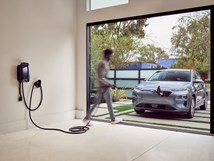Toyota Research Institute Building Own Test Track
The Toyota Research Institute (TRI) is continuing its methodical moves toward developing automated vehicle technology as it announced today that it has filed the paperwork to build a closed-loop test facility within a 1.5-mile oval test track at the Michigan Technical Resource Park in Ottawa Lake, Michigan, which is northwest of Toledo and pretty much a straight shot 40 miles down U.S. 23 from Ann Arbor.
The Toyota Research Institute (TRI) is continuing its methodical moves toward developing automated vehicle technology as it announced today that it has filed the paperwork to build a closed-loop test facility within a 1.5-mile oval test track at the Michigan Technical Resource Park in Ottawa Lake, Michigan, which is northwest of Toledo and pretty much a straight shot 40 miles down U.S. 23 from Ann Arbor.
While TRI has established partnerships with the test facilities of Mcity (Ann Arbor), American Center for Mobility (Ypsilanti Twsp., Michigan) and GoMentum Station (Concord, California), as Ryan Eustice, TRI senior vice president of automated driving, noted, “By constructing a course for ourselves, we can design it around our unique testing needs and rapidly advance capabilities, especially with Toyota Guardian vehicle mode.”

Within that oval Toyota Research Institute will build an automated vehicle test facility that’s scheduled to be open in October.
Guardian is one of two automated driving modes being developed at TRI, with the other named Chauffeur. Guardian’s purpose is to essentially operate in the background while a human drives the vehicle, coming into effect when it is determined that a potential crash is likely. Chauffeur, as its name implies, drives the car.
TRI will be building a four-lane divided highway with high-speed entrance and exit ramps, an area with congested conditions, and a skid pad for slick surfaces.
“This new site will give us the flexibility to customize driving scenarios that will push the limits of our technology and move us closer to conceiving a human-driven vehicle that is incapable of causing a crash,” Eustice said.
While that may sound a bit extreme—incapable?—it probably wouldn’t be wise to bet against them. Keep in mind that on staff they have some of the world’s leading roboticists, AI and deep learning researchers and developers, and others who are dedicated to the task.
RELATED CONTENT
-
On Automotive: An All Electric Edition
A look at electric vehicle-related developments, from new products to recycling old batteries.
-
On the Genesis GV80, Acura MDX, BMW iDrive and more
From Genesis to Lamborghini, from Bosch to Acura: new automotive developments.
-
On Zeekr, the Price of EVs, and Lighting Design
About Zeekr, failure, the price of EVs, lighting design, and the exceedingly attractive Karma


.jpg;width=70;height=70;mode=crop)






